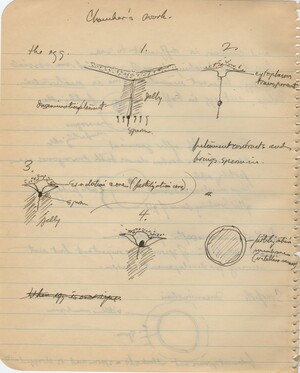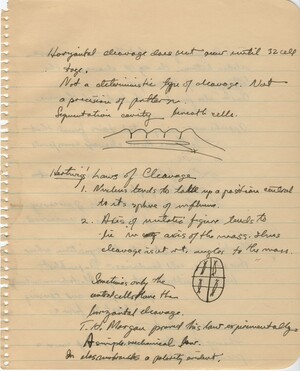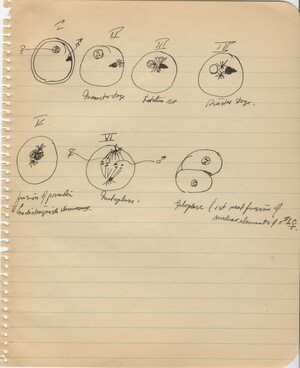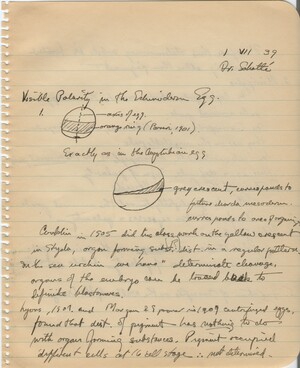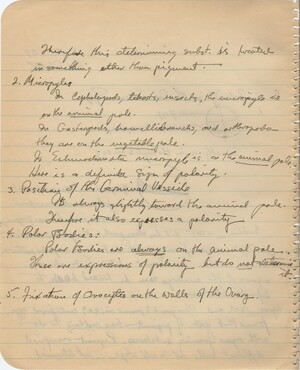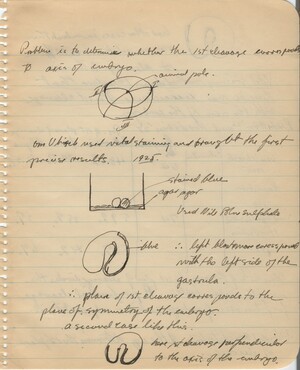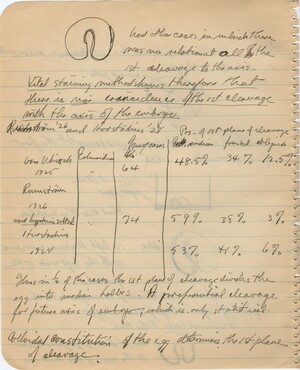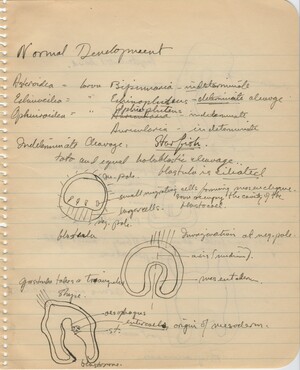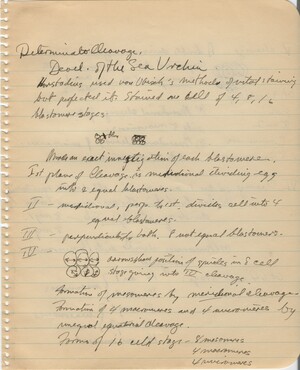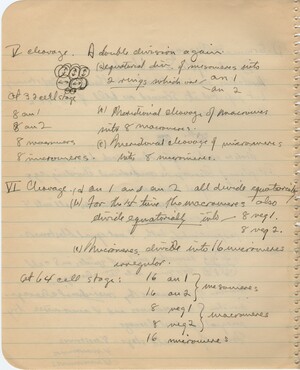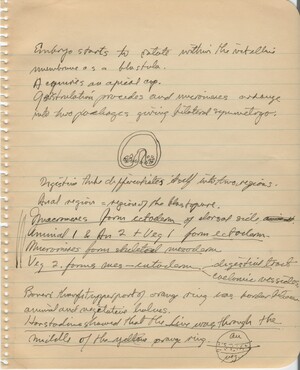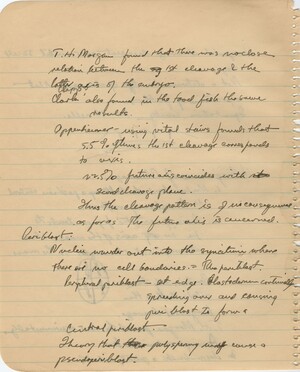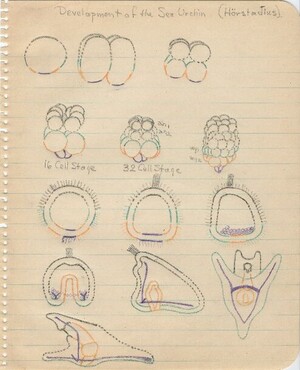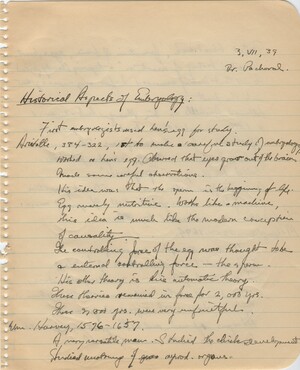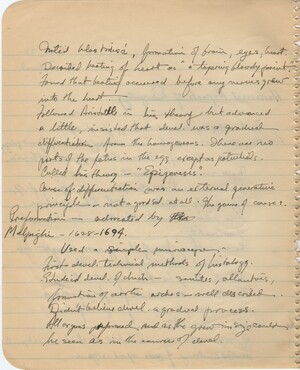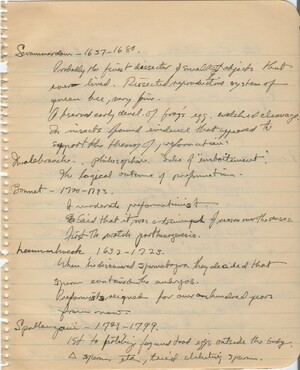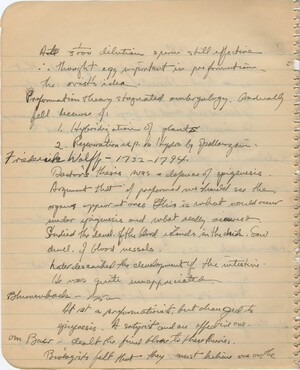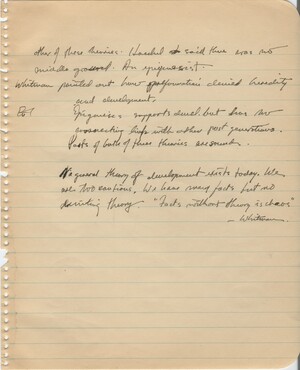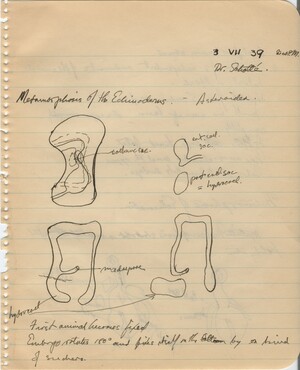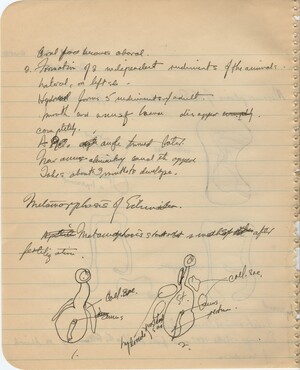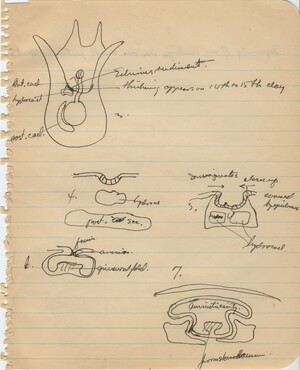Photographs
Notes from Oscar Schotte's lecture. Trinkaus draws 4 labeled diagrams of Chamber's work on fertilization in starfish
Notes from Hubert Goodrich's lecture. Trinkaus continues cleavage notes from page 6. Begins a new section on 'Hertwig's Laws of Cleavage'
Notes from Oscar Schotte's lecture. Trinkaus draws 6 diagrams of fertilization and the first cell division.
Notes from Oscar Schotte's lecture. Trinkaus begins notes on the 'Visible Polarity in the Echinoderm Egg' with two labeled diagrams and notes on the history of research on the topic.
Notes from Oscar Schotte's lecture. Trinkaus continues his notes on the echinoderm egg with the determination that "Therefore this determining subst. is located in something other than pigment." He creates four categories for his notes on this page: 'Micropyles', 'Position of the Germinal Vessicle', 'Polar Bodies', and 'Fixation of Oocytes on the walls of the Ovary'
Notes from Oscar Schotte's lecture. Trinkaus continues his notes on the echinoderm egg with information about the position of first cleavage relative to the axis of the embryo, with four diagrams
Notes from Oscar Schotte's lecture. Trinkaus continues his notes on the echinoderm egg notes about the position of the first cleavage relative to the axis of the embryo. He offers results of various researcher's studies and concludes that "Vital staining method shows therefore that there is no coincidence of the 1st cleavage with the axis of the embryo"
Notes from Oscar Schotte's lecture. Trinkaus begins notes on 'Normal Development' with information on Asteroidea, Echinoidea, Ophiuroidea, including 3 labeled diagrams
Notes from Oscar Schotte's lecture. Trinkaus continues his notes on normal development of the echinoderm egg from the previous page with 3 labeled diagrams
Notes from Oscar Schotte's lecture. Trinkaus takes notes on 'Determinate Cleavage' and the 'Devel. Of the Sea Urchin', including information on the the first 4 stages of cleavage
Notes from Oscar Schotte's lecture. Trinkaus continues his notes from the previous page on the cleavage of the sea urchin embryo with information about the 5th (with diagram) and 6th stages of cleavage
Notes from Oscar Schotte's lecture. Trinkaus continues his notes from the previous page on early development of the sea urchin embryo
Notes from Hubert Goodrich's lecture. Trinkaus continues cleavage notes from page 7. Begins a new section on 'Periblast'
Notes from Oscar Schotte's lecture. Trinkaus creates color diagrams of the 'Development of the Sea Urchin (Horstadius)'
Notes from Charles Packard's morning lecture, "Topics from the history of embryology". Trinkaus takes notes on the history of embryology beginning with Aristotle and William Harvey
Notes from Charles Packard's lecture. Trinkaus continues his notes from Packard's morning lecture on the history of embryology (begin page 81) with more information about Harvey, then Preformation, and Malpighi
Notes from Charles Packard's lecture. Trinkaus continues his notes from Packard's morning lecture on the history of embryology (begin page 81) with information on Swammerdam, Malebranche, Bonnet, Leeuwenhoek, and Spallanzani
Notes from Charles Packard's lecture. Trinkaus continues his notes from Packard's morning lecture on the history of embryology (begin page 81) with continued notes on Spallanzani's work, Wolff, Blumenbach, and von Baer
Notes from Charles Packard's lecture. Trinkaus concludes his notes from Packard's morning lecture on the history of embryology (begin page 81) with some final thoughts from C.O. Whitman about epigenesis, heredity, and development, ending with the quote, "Facts without theory is chaos."
Notes from Oscar Schotte's lecture. Trinkaus begins notes on the 'metamorphosis of Echinoderms' with four diagrams of an echinoderm embryo
Notes from Oscar Schotte's lecture. Trinkaus continues notes from page 86 on the metamorphosis of echinoderms with general notes on rudimentary formation. Includes two diagrams (labeled 1 and 2).
Notes from Oscar Schotte's lecture. Trinkaus continues notes from page 86 on the metamorphosis of echinoderms with five more diagrams (labeled 3-7).
Notes from Oscar Schotte's lecture. Trinkaus concludes notes from page 86 on the metamorphosis of echinoderms with a single line.
Notes from Hubert Goodrich's lecture. Trinkaus continues Periblast notes from page 8. Begins a new section on 'Gastrulation' with two diagrams of the 'embryonic shield', and a diagram and explanation of 'Kupffer's Vessicle'

